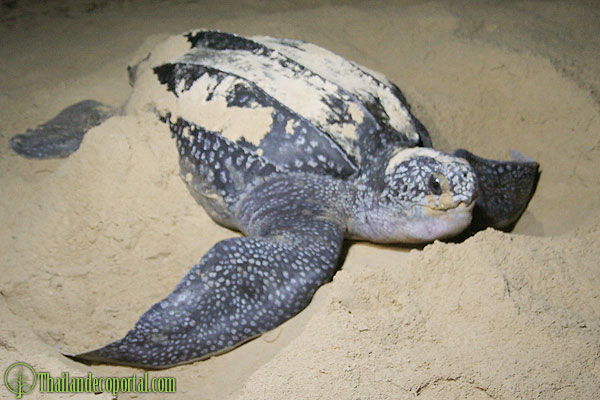
©David Witherall and Blaize Harth: Leatherback Sea Turtle (Dermochelys coriacea), Ocean Freedom offshore from Cairns
Colours
Distinguishing features
The leatherback has several characteristics that distinguish it from other sea turtles. Its most notable feature is the lack of a bony carapace. Instead of scutes, it has thick, leathery skin with embedded minuscule osteoderms. Seven distinct ridges rise from the carapace, crossing from the anterior to posterior margin of the turtle's back.
The entire turtle's dorsal surface is colored dark grey to black, with a scattering of white blotches and spots. The turtle's underside is lightly colored.
Instead of teeth, the leatherback turtle has points on the tomium of its upper lip, with backwards spines in its throat to help it swallow food and to stop its prey escaping once caught. The teeth are not used for mastication. (Wikipedia)
Size
- Up to 225 cm (Total length including head and tail)
Weight
- Up to 700 kg
Synonyms
Interesting facts
- Leatherback turtles are one of the deepest diving marine animals. Individuals have been recorded diving to depths as great as 1,280 metres. Typical dive durations are between 3 and 8 minutes, with dives of 30–70 minutes occurring infrequently. (Wikipedia)
Distribution
Distribution and habitat preferences
The leatherback turtle is a species with a cosmopolitan global range. Of all the extant sea turtle species, the leatherback has the widest distribution, reaching as far north as Alaska and Norway and as far south as the Cape of Good Hope in Africa and the southernmost tip of New Zealand. The leatherback is found in all tropical and subtropical oceans, and its range extends well into the Arctic Circle.
There are three major, genetically distinct populations, in the Atlantic, eastern Pacific and western Pacific Oceans.
While nesting beaches have been identified in the region, leatherback populations in the Indian Ocean remain generally unassessed and unevaluated. (Wikipedia)
Diet
Adult Leatherback Turtles subsist almost entirely on jellyfish. Due to their obligate feeding nature, leatherback turtles help control jellyfish populations. Leatherbacks also feed on other soft-bodied organisms, such as tunicates and cephalopods. (Wikipedia)

